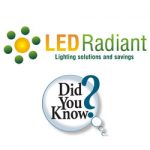Welcome back!
In our last article of things you must know before switching to LED we saw what are the different technologies that we might be replacing and an easy formula to estimate the equivalent wattage for an LED (for an LED technology that generates around 130 lumens per watt).
Now it is time to review some concepts that you MUST understand in order to make the right decision when it comes to choose LED lamps or fixtures. These are some of the things you must know.
What follows are informal definitions, not academic ones. This is because our goal is for you to quickly understand the ideas and not to make a scientific dissertation about them.
Some definitions:
WATTAGE:
This is how much energy the lamp uses to function, therefore the smaller the number, the less you spend in your electric bill. In our website, here, on the left hand side, you can search by making a selection by wattage.
TYPE OF TUBES:
Tubes are measured by how long they are (in feet or inches and from pin to pin)) and how thick they are (the diameter, in 8th of an inch:
| Name | Diameter | or |
| T4: | ½” | ½” |
| T5: | 5/8” | 5/8” |
| T8: | 8/8” | 1” |
| T9: | 9/8” | 1 1/3” |
| T10: | 10/8” | 1 ¼ “ |
| T12: | 12/8” | 1 ½ ” |
You can find more information about tubes in our website following this link.
BASE or CONNECTOR:
FOR BULBS:
The metallic twisting part of the bulb that holds it in place. It can be:
- E26, Edison or Medium: Is the standard base that you find in a household. The number is due to the diameter in millimeters of the base, in this case 26. Click here to see our products with an E26 Base
- E39 or Mogul: More often used in an industrial or commercial setting. While it looks the same as the E26, it is a little bit bigger (39 millimeters diameter). A list of all our products with a base E39 can be found here.
 Medium and Mogul Base
Medium and Mogul BaseFOR TUBES:
The metallic single, dual or 4 pin connector that is at the end of each side of the tube. It can be:
- Bi-pin G13: 12.7mm (or 0.5”) from pin to pin. You will find this connectors in almost every T12’s, T10’s & T8’s tubes.
- Bi-pin G5: 5mm from pin to pin. They are in T4’s & T5’s tubes.
- FA8, nipple or single pin: In 8 footers tubes.
- R17d, Recessed double contact: Only in high output lumens tubes, not common.
LENS:
Another one of the things you must know is what a lens is and if it has any kind of impact in your buying decision. The lens is the covering or protection of the light that might also provide diffusion or not.
It can be clear (you can see through) or frosted, milky or white (you cannot see through).
This is just an aesthetic option. If the light will be at eye level, we suggest buying frosted, otherwise, any of the 2 will do.
Even though one gives out a tiny bit more of lumens than the other, our eyes are not able to see the difference.
Stay tuned, since in our next posting, we'll review the concepts of color temperature, IP and lumens and with that you will be ready to buy knowledgeably your next LED's.
We truly hope this information is helpful for you and, furthermore, helps reducing researching time and ease your transition to LED lighting.
Since we are here to help, please do not hesitate contacting us for more information or to show you different economical options for your next LED switch.
Have a wonderful and illuminated week!


 Incandescent Bulb
Incandescent Bulb CFL Lamps
CFL Lamps HPS Lamps
HPS Lamps Metal Halide Lamps
Metal Halide Lamps













